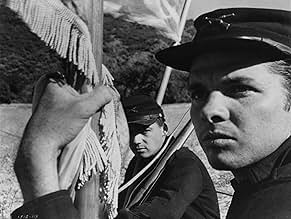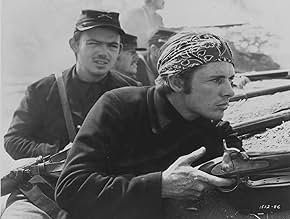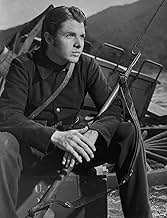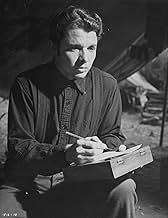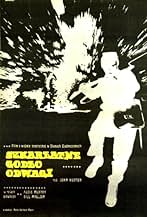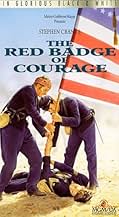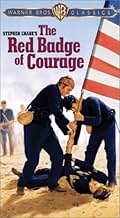IMDb RATING
7.1/10
5.2K
YOUR RATING
Truncated adaptation of Stephen Crane's novel about a Civil War Union soldier who stuggles to find the courage to fight in the heat of battle.Truncated adaptation of Stephen Crane's novel about a Civil War Union soldier who stuggles to find the courage to fight in the heat of battle.Truncated adaptation of Stephen Crane's novel about a Civil War Union soldier who stuggles to find the courage to fight in the heat of battle.
- Director
- Writers
- Stars
- Nominated for 1 BAFTA Award
- 2 wins & 1 nomination total
Robert Easton
- Thompson
- (as Robert Easton Burke)
Don Anderson
- Soldier
- (uncredited)
Smith Ballew
- Union Captain
- (uncredited)
Albert Band
- Union Soldier Fording River
- (uncredited)
Gregg Barton
- Soldier
- (uncredited)
Whit Bissell
- Wounded Officer
- (uncredited)
Robert Board
- Soldier
- (uncredited)
Chet Brandenburg
- Wounded Soldier
- (uncredited)
Edwin Breen
- Confederate Flag Bearer
- (uncredited)
Joe Brown Jr.
- Soldier
- (uncredited)
- Director
- Writers
- All cast & crew
- Production, box office & more at IMDbPro
Featured reviews
This movie, directed by John Huston, is arguably the finest Civil War movie of all time. The performances by the young Audie Murphy,America's most decorated soldier and all the cast are as true to life as can be found anywhere. The narration and ultra-realism gives an almost docu-drama feel. This movie is so short,at 69 minutes, that it never had a chance at the box office, and instead was probably seen mostly by school kids and a few old movie buffs. The only other movie that is almost as short and so successfully tells a story is "The Petrified Forest". The Red Badge of Courage is on my best movies of all time list.
Although John Huston's The Red Badge of Courage has stood the test of time critically, back then it lost lots of money in its first release. The film was a bone of contention between Louis B. Mayer and Dore Schary who were locked in a power struggle for control at Metro-Goldwyn- Mayer. Schary wanted to make the film, Mayer said it would flop and he was proved right. He also got ousted anyway.
The Red Badge of Courage refers to the blood that gets spilled should you sustain a battle wound. If you remember in Oliver Stone's Platoon, the men don't treat new arrival Charlie Sheen until he's gotten one of those. Here the Red Badge is something to be avoided if possible.
By a piece of serendipity when Audie Murphy returned from World War II and was deciding on a career, he chose the movies. He certainly was loaded down with offers, but I guess he sensed in himself an inner gift for being an actor. Not Marlon Brando or Laurence Olivier, but someone in the hands of the right director could get a good performance out of him. In John Huston he found that director, twice in fact as he later worked with him in The Unforgiven.
There was no need for research because our most decorated soldier in history lived the research in North Africa and Europe. There's a dimension to Audie's performance and that of GI cartoonist Willard Mullin that no training at the Actor's Studio could have given them. Murphy just summoned his memories of what it was like to be a kid from Texas whisked off to Europe the way young Henry Fleming is facing the Confederates in their backyard.
Murphy gets good support from an able cast of people like Arthur Hunnicutt, Royal Dano, John Dierkes, and Andy Devine as various other soldiers in the Union Army, all citizens serving their country. No career people in this crowd. Also James Whitmore, reading the narrative of Stephen Crane's novel serves almost like another cast member and moves the film's story line along.
Though it lost money for MGM, The Red Badge of Courage is still a fine film with some great insights into the meaning of battlefield bravery.
The Red Badge of Courage refers to the blood that gets spilled should you sustain a battle wound. If you remember in Oliver Stone's Platoon, the men don't treat new arrival Charlie Sheen until he's gotten one of those. Here the Red Badge is something to be avoided if possible.
By a piece of serendipity when Audie Murphy returned from World War II and was deciding on a career, he chose the movies. He certainly was loaded down with offers, but I guess he sensed in himself an inner gift for being an actor. Not Marlon Brando or Laurence Olivier, but someone in the hands of the right director could get a good performance out of him. In John Huston he found that director, twice in fact as he later worked with him in The Unforgiven.
There was no need for research because our most decorated soldier in history lived the research in North Africa and Europe. There's a dimension to Audie's performance and that of GI cartoonist Willard Mullin that no training at the Actor's Studio could have given them. Murphy just summoned his memories of what it was like to be a kid from Texas whisked off to Europe the way young Henry Fleming is facing the Confederates in their backyard.
Murphy gets good support from an able cast of people like Arthur Hunnicutt, Royal Dano, John Dierkes, and Andy Devine as various other soldiers in the Union Army, all citizens serving their country. No career people in this crowd. Also James Whitmore, reading the narrative of Stephen Crane's novel serves almost like another cast member and moves the film's story line along.
Though it lost money for MGM, The Red Badge of Courage is still a fine film with some great insights into the meaning of battlefield bravery.
Deserves more credit than it currently receives. The directing alone is awesome, with the number of unique and different shots that Huston came up with really takes this Pic away from the norm.
Some of the realism in the portrayals that would be lost on some American viewers include the scene where the General talks to the troops before the battle, asking them what they are going to eat for dinner. He goes from group to group asking the same questions - why? Remember (duh), no radios, no public address system. Commanders had to spread their message by repeating it over and over - inspiring a different group each time.
A very enjoyable 69 minutes. Sad that the studio had to meddle with the original cut (what else is new?).
F
Some of the realism in the portrayals that would be lost on some American viewers include the scene where the General talks to the troops before the battle, asking them what they are going to eat for dinner. He goes from group to group asking the same questions - why? Remember (duh), no radios, no public address system. Commanders had to spread their message by repeating it over and over - inspiring a different group each time.
A very enjoyable 69 minutes. Sad that the studio had to meddle with the original cut (what else is new?).
F
Keep in mind that many people involved with this film were WW2 vets. That's important, as I think it made a HUGE difference in how the film came out. Audie Murphy was the most decorated American soldier of WW2. Bill Mauldin wasn't a line soldier, but he'd been in the infantry before the war. He knew what the daily life of a grunt was all about. And director John Huston had directed films in WW2, standing at the front lines in Italy to do so. They all knew what war should look like. Had these people not been involved, I think this movie wouldn't have rung true as it did then and does today. Sure, the weapons, most of the uniforms and equipment are horribly wrong (this was in the days when a "trapdoor" Springfield rifle and Indian War era equipment was just fine for a Civil War film), but this film must be viewed on it's acting and photography. They got it across what it was like to be SHOT at, and how it felt to be terrified in battle, better than any film since, "All Quiet of the Western Front." Yes, it's seriously abridged and condensed (quite a feat when you consider how short the book is), but it gets the spirit across just fine. It's not perfect by any measure, but you'll never be able to get such a group together to re-make this film and have ring as trued as this classic.
Such a darn shame so much of the film was lost during a power struggle at MGM. What remains is a strong drama adapted from the Crane novel. Some call it an anti-war film, but that's a stretch since Audie Murphy's youthful soldier proves himself in battle after a cowardly initiation, and receives the admiration of his buddies. The sequence is more like a rite of passage than a denunciation.
The somewhat amateur cast is outstanding. I expect the untrained Murphy felt a personal commitment to his role and comes through just as professionally as he did in real life. Untrained cartoonist Bill Mauldin also looks and acts the part of callow youth maturing under pressures of life or death situations. His big ears are especially persuasive for a Hollywood setting.
And what burst of inspiration led the normally glamor-obsessed Tiffany of Studios to cast such affecting unlovelies as John Dierkes and Royal Dano in key parts. It's Dierkes's ill-fated salt-of-the-earth soldier that injects real tragedy into the sparse dialogue. With his craggy face and towering body he's every inch the early American primitive. And, of course, there's Dano with his gaunt face, wasted body, and graveyard voice, who helps make that line of wounded soldiers (the real core of the film) an unforgettable procession. Nor should that genuine face of war, the battle-shocked soldier deliriously bellowing The Battle Hymn of the Republic as he trudges along, be overlooked. And for a little humorous relief, who can forget the general whose pep-talk to each unit sounds like a broken record with a big stomach, but whose humanity shines through anyway.
The sweeping battlefields are effective in their look and feel, even if it is the scrublands of SoCal in the distance. Note all the dust and smoke obscuring vision, along with the chaotic criss-crossing of other units going here and there, but we don't know where. The effect is that of focusing our concerns on the familiar faces rather than on who's winning or losing the battle, which, I gather, is the way most infantry experience battle. It's been called understandably "the fog of war".
I like the brief lyrical moments that remind us of a larger world outside the stage of human conflict. Actually, Murphy is quite good at portraying sensitivity, as for example when he turns away from the raucous byplay at the farm house. The quiet moments with him and Mauldin are rather touching in that they look like two average Joe's showing the personal side of war. But, as Murphy proved in both the movie and real life, you never know the depths that may be concealed under that ordinary appearance.
I believe it was critic Andrew Sarris who pointed out that John Huston's career was never the same after MGM got through editing out an hour of his version and throwing the rest away. Now we can only guess how many other affecting scenes were tossed out in the process. Obviously, the project was close to Huston's heart being an adaptation of a great American novel from its most wrenching national conflict. I don't know whether to be happy or sad that this severely truncated version was finally marketed. It's good, but then there's the promise of so much more. Too bad the production didn't migrate to a less image-conscious studio.
The somewhat amateur cast is outstanding. I expect the untrained Murphy felt a personal commitment to his role and comes through just as professionally as he did in real life. Untrained cartoonist Bill Mauldin also looks and acts the part of callow youth maturing under pressures of life or death situations. His big ears are especially persuasive for a Hollywood setting.
And what burst of inspiration led the normally glamor-obsessed Tiffany of Studios to cast such affecting unlovelies as John Dierkes and Royal Dano in key parts. It's Dierkes's ill-fated salt-of-the-earth soldier that injects real tragedy into the sparse dialogue. With his craggy face and towering body he's every inch the early American primitive. And, of course, there's Dano with his gaunt face, wasted body, and graveyard voice, who helps make that line of wounded soldiers (the real core of the film) an unforgettable procession. Nor should that genuine face of war, the battle-shocked soldier deliriously bellowing The Battle Hymn of the Republic as he trudges along, be overlooked. And for a little humorous relief, who can forget the general whose pep-talk to each unit sounds like a broken record with a big stomach, but whose humanity shines through anyway.
The sweeping battlefields are effective in their look and feel, even if it is the scrublands of SoCal in the distance. Note all the dust and smoke obscuring vision, along with the chaotic criss-crossing of other units going here and there, but we don't know where. The effect is that of focusing our concerns on the familiar faces rather than on who's winning or losing the battle, which, I gather, is the way most infantry experience battle. It's been called understandably "the fog of war".
I like the brief lyrical moments that remind us of a larger world outside the stage of human conflict. Actually, Murphy is quite good at portraying sensitivity, as for example when he turns away from the raucous byplay at the farm house. The quiet moments with him and Mauldin are rather touching in that they look like two average Joe's showing the personal side of war. But, as Murphy proved in both the movie and real life, you never know the depths that may be concealed under that ordinary appearance.
I believe it was critic Andrew Sarris who pointed out that John Huston's career was never the same after MGM got through editing out an hour of his version and throwing the rest away. Now we can only guess how many other affecting scenes were tossed out in the process. Obviously, the project was close to Huston's heart being an adaptation of a great American novel from its most wrenching national conflict. I don't know whether to be happy or sad that this severely truncated version was finally marketed. It's good, but then there's the promise of so much more. Too bad the production didn't migrate to a less image-conscious studio.
Did you know
- TriviaAfter seeing what MGM had done to the film, John Huston instructed his agent to include a clause in all future contracts guaranteeing that he would receive a copy of his director's cut on all of his films.
- GoofsBeginning at 14:28, several Union soldiers wading across the waist-deep river and later climbing out of the river are carrying the U.S. Rifle Model 1903, also known as the Springfield Model 1903. Note especially the soldier who climbs out of the river holding his rifle above his head. The Model 1903 is a bolt-action, magazine-fed rifle that was adopted by the US Army in 1903 and used in World Wars I and II, but not the American Civil War which was fought from 1861-1865.
- Quotes
The General: Howdy Jim, Corporal. How are those wounds?
Soldier: Stinging some, General, but they're a-mending.
The General: That's fine, fine. Anybody care for a chaw?
- ConnectionsEdited into Hollywood: The Dream Factory (1972)
- How long is The Red Badge of Courage?Powered by Alexa
Details
Box office
- Budget
- $1,640,000 (estimated)
- Runtime
- 1h 9m(69 min)
- Color
- Aspect ratio
- 1.37 : 1
Contribute to this page
Suggest an edit or add missing content


